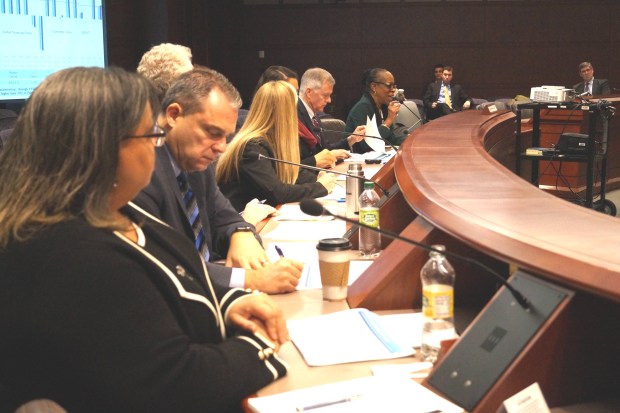As it decides what recommendations to make toward putting Connecticut’s pension funds on more secure footing, the state’s Pension Sustainability Commission today heard from State Treasurer Denise Nappier about the history of funding for the teachers’ retirement fund, the largest pension fund overseen by the treasury.

State Treasurer Denise Nappier and staff for the Office of the State Treasurer presented to the state’s Pension Sustainability Commission today.
“We must ensure the sustainability of the fund so that it can provide the retirement benefits we have promised to our retired and current teachers,” Nappier said. “They deserve no less.”
Before 1979, Connecticut paid teacher’s retirement benefits out of each year’s state budget—what is known as a “pay as you go” model. After that, the state created an actuarially designed plan with the objective of requiring the state to pay an annual amount to cover both current benefits for retirees and part of the unfunded past liability. The method that was used for calculating the state’s payments escalated costs over time.
Even after this actuarially designed plan was adopted, elected officials put off funding it.
“The state has been in trouble for a long time,” Nappier said.
She added that three factors led to the poor health of the fund as measured by its funding ratio:
- playing catch-up for costs incurred before 1979,
- consistent underpayment of the state’s actuarially determined payments, and
- unrealistic long-term investment return assumptions.
Because the state continually paid less than was deemed necessary by actuaries, amounts contributed to the fund were not able to be invested—meaning the state lost out on investment income that would have helped it meet its pension obligations.
From 1991 through 2005, the state failed to pay $979 million in required contributions to the Teachers’ Retirement Fund. Had that money been paid into the fund, taxpayers would have saved approximately $5 billion.
This underfunding also increased the fund’s unfunded liability, compounding the increase in later payments.
In 2008, at CEA’s urging, the state issued pension obligation bonds to fund part of the unfunded liability of the Teachers’ Retirement Fund.
“One of the most significant aspects of this transaction was a covenant that obligated the state to fully pay what was acutarially required for as long as those bonds remained outstanding,” said Christine Shaw, chief compliance officer for the Office of the State Treasurer. “This proved to be an essential aspect of the funding discipline, as we’ve seen the longest sustained period of full funding for teachers’ retirement was during the period that covenant has been in place.”
CEA Retirement Specialist Robyn Kaplan-Cho urged her fellow commission members to note this fact as they consider recommendations to include in their final report.
“Anything that’s statutory can just be changed by an act of the legislature,” Kaplan-Cho said. “Which is what got us into trouble in the first place.”
The commission will meet again November 28 to discuss specific recommendations for its final report.
Subscribe to BlogCEA for further updates on the commission’s work.







